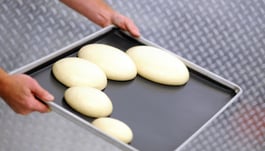
Like a hundred times before, you consult your favorite recipe, mix your pizza dough and let it proof. This time, though, you return to discover that your dough hasn’t risen. Or, perhaps the discovery of flat, lifeless crust happens when you take your pizza out of the oven. Why didn't your pizza dough rise? What happened?
Why is Your Pizza Dough Not Rising?
The answer lies in the balance of ingredients, climate and preparation. Too much or too little of any or all of these factors and your made-from-scratch pizza dough won’t rise to the occasion.
Pizza Dough Ingredients
Don’t let the simplicity of your pizza dough ingredients — flour, yeast, water — fool you. Mishandling the basics can really complicate whether your dough will or will not rise properly. Consider how the characteristics of each of the following main ingredients may impact your results.
Flour
The protein and moisture content in flour varies by type and can indirectly impact your pizza dough not rising. Standard bread flour, for example, contains relatively low protein levels which creates a bread-like texture in the final product. Pizza flour, on the other hand, typically has more protein and will give the pizza a more distinct texture and structure.
Although flour is considered a dry ingredient, it may contain varying levels of moisture. The actual percentage of moisture content can be different depending on the type of flour being used, but even tiny amounts must be factored into how much you hydrate your dough. If not, your recipe can be thrown off and your dough texture will be compromised, causing your pizza dough not to rise properly.
Yeast
For a proper rise, yeast is imperative. Three major factors can impact how effective your yeast is:
- Improper activation — While instant yeast can be added directly to the flour, active dry yeast must be activated ahead of time. This entails placing the yeast in a small bowl and combining it with a little sugar and tepid water. If the yeast froths and expands in 10-15 minutes, it’s a good batch; if not, you’ll need to start again. Without these telltale signs, your pizza crust won’t rise.
- Not enough yeast — As with any recipe, ratios matter, but these proportions can vary from one batch to another. Colder temperatures, for example, may require that up to 10% more yeast be used per batch to achieve proper rise.
- Storage temperature — Fresh or compressed yeast must be stored at the proper temperature (usually no higher than 45°F) to work correctly; temperatures running too hot or too cold will significantly decrease its performance and you’ll likely end up with disappointing results.
Water
Water temperature plays a pivotal role in yeast activation. Warm temperatures are a good thing; whereas hot temperatures are too much of a good thing. Remember that yeast is a living organism and, as such, is sensitive to its environment. Warm water will encourage fermentation of the yeast and, by extension, a “healthy” dough rise. Excessively hot water, however, will actually kill the yeast, impede fermentation and, ultimately, your dough will not rise.
Additional Factors
Climate
Temperature considerations are not limited to water when it comes to helping your dough rise. Pay attention to your kitchen conditions, carefully monitoring humidity and temperature levels.
If circumstances aren’t ideal, you can control your environment to maximize crust performance. In hot and humid weather, for example, refrigerating the dough for a longer period of time may be enough to do the trick. If your prep area is too cold, scout out warmer areas in your kitchen – perhaps next to a stove or heater – where you can place your dough bowl as it rises. If all else fails, you can try placing the bowl containing your dough in a warm water bath to speed up how quickly it rises. Even when the surrounding climate or environment isn’t ideal, there are clever ways to trick your dough into performing the way it should.
Preparation
Even when it seems like all the conditions are right, it’s important to work with your dough properly. Check your best practices to ensure the following steps have been covered:
- Proofing — Don’t take shortcuts with the proofing process. Proper fermentation and incorporation of the yeast are the keys to obtaining optimal dough rise.
- Docking — Uncontrolled bubbles result from a lack of proofing, a lack of proper docking, or both. Equip your kitchen with the right tools for producing perfect pies.
- Storage — Inconsistent refrigeration temperatures and inattention to shelf life will impact dough rise. Aim for a temperature of 38°F for two days in the refrigerator, then a 40-60 minute rest at room temperature before using it. Refrigerated dough shelf life is about 4-5 days, depending on the recipe and quality of proofing. As is true with most ingredients, the fresher the better.
- Baking — Maximize rise by allowing your dough to warm to room temperature prior to putting it in the oven.
Learn more ways to address common pizza dough frustrations in our guide below!





